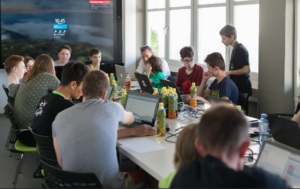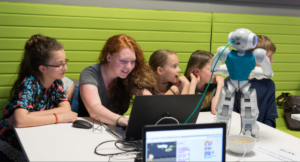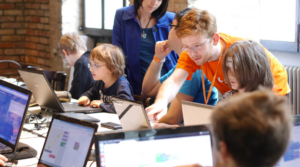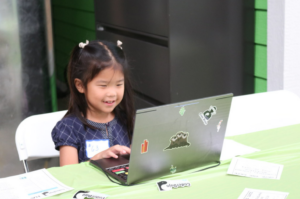I’ve been passionate about kids coding for well over a decade now, way before the learning center run by high schoolers came to your strip mall. As I look back at those early days, I am proud not just of the 1-on-1 project-based learning that Breakout Mentors provides our students, but also of volunteering to start a Silicon Valley chapter of the world’s largest kids coding club!
What is a Kids Coding Club?

Code clubs are all different shapes and sizes. Each and every one is unique, so it is hard to pinpoint a perfect example, but they all share similar characteristics. A kids coding club is usually an in person meeting intended to give kids an educational environment to explore the fascinating world of coding and technology.
Some clubs are set up more like lessons, with a certain goal to achieve during the meeting. Others are entirely unstructured, where the goal is to put like-minded people in the room and get out of the way, letting them explore at their own pace.
CoderDojo is the Largest Kids Coding Club
CoderDojo is an international organization of free programming clubs for kids, with local chapters all over the world. It started in Ireland in early 2011 and the growth has been staggering, especially in the first few years. Volunteers in 100 countries have created local chapters!
Each chapter is fairly independent, united by a common goal: give kids access to coding at a young age. In the United States, many are held at local libraries or community event centers. But it is also common for a business to donate use of a conference room or cafeteria on nights or weekends. No matter the club’s format or size, the goal is to give the children access to coding at a young age.
It is supported by the non-profit CoderDojo Foundation and even sponsors international events like the annual Coolest Projects.
Starting the Silicon Valley CoderDojo

Photo by: Rainer Stropek
Is there anywhere more iconic for coding than Silicon Valley? Back in 2012, hardly anyone talked about getting kids to code, but if there is anywhere there should be interest, it would be here. The technology industry is massive in the San Francisco Bay Area, with many parents working in the industry, and provides early exposure for local kids.
One passionate parent, Marcy, approached me to be the technical expert for the kids coder club. Breakout Mentors had launched earlier in the year and we were discussing 1-on-1 mentorship for her young son. However, she was also interested in forming a club, just needed someone with coding experience to know how to run it.
Marcy and I were the ones driving the Silicon Valley CoderDojo forward in the early days. Her son loved coding, but didn’t know anyone else who was interested, so she really wanted to form a great community experience. She worked tirelessly to find a venue and get the word out about the new kids coding club.
The First Meeting at Microsoft

Photo by: Rainer Stropek
The Microsoft office in Mountain View was generous enough to donate a huge conference room for CoderDojo Silicon Valley to use for the coding sessions. They would end up being an important partner as the club would grow in the coming years.
I was in charge of the content: what should we point the kids to work on? Here is what I wrote the next day about the first session:
The meeting was only loosely structured – there was a wide range of student age and experience, so not everyone worked on the same project. Breakout Mentors Founder Brian Skinner was the lead mentor for the session and presented several different Scratch games for the students to choose from. Based on their previous experience and interest, they could choose which one they wanted to make, or even pursue their own engaging projects! The result was great student engagement. With 8 mentors walking around the room ready to assist, no question was left unanswered.
We were thrilled with how it went. Some parents of the children were technical with a coding background themselves, and they became core contributors to the “wandering mentoring” team. They were able to make sure that if a kid got stuck, it wouldn’t lead to frustration, so they could keep deepening their interest in coding.
Growing the Club
Over the next several years, Silicon Valley CoderDojo continued to grow. I distinctly remember the first intermediate Python project focus, when I created a Wheel of Fortune starter code as one of many fun projects for the students to create. I came to appreciate the key difference between mentoring 1-on-1 knowing the student’s previous experience to a large group of varying abilities.
We quickly outgrew the original space and found we actually preferred separate rooms for different age groups or programming languages. Microsoft continued to be the primary corporate sponsor, next giving large corporate training rooms with removable walls between them. We were able to fit a hundred students per session, spread out into three separate rooms with different hands-on activities!
As the club expanded, we also found other corporate sponsors to host events. The complexity of managing it all grew even faster. Not so much on the technology side, although there were discussions about learning pathways for intermediate to advanced students, but on the event management side. One of the parent volunteers created a software system just to manage the process of requesting tickets since there was always more interest than capacity.
What Did the Kids Learn?

We covered a huge range of coding languages and projects. The core languages were Scratch and Python for game design, but we also did a lot of HTML web development and JavaScript. We explored more advanced platforms like Unity, Minecraft mods, and even Corona SDK mobile games using. Our teaching materials are still available on Github here.
In order to help kids go from beginner to intermediate, I pushed for getting the same kids to return each week for a while. From a learning standpoint, it just isn’t very effective to have a new person each week who needs help understanding the basics, and everyone else is already past that point. This led to some of our tracks being offered as a six-week series, rather than standalone events.
However, after completing six weeks as a CoderDojo Silicon Valley member, we wanted those kids to feel like they were a core part of the coding club. So rather than offer a more advanced version of what they last worked on (e.g. Python), which not everyone might be ready for, it was easier to switch them to something new (e.g. web development). It is nearly impossible in education to advance a whole group of kids simultaneously.
This Sounds Complex
By 2016, after three incredible years running CoderDojo Silicon Valley, it became clear to me that we would have to simplify in order to make it sustainable. Marcy was still tirelessly dedicating her time, which was approaching a full-time job, while we had many other dedicated parents spending dozens of hours a week volunteering. Some of those key parent volunteers even had their kids “age out” into high school or other activities, so their own child wasn’t even participating anymore.
The teaching and learning side wasn’t even the most difficult part. It isn’t as ideal a learning environment as 1-on-1 with Breakout Mentors, but I knew as we built up our resources, they could continue to be used for kids in future years.
The ticketing and event management became even more difficult. Certain venues required emails and name badges for security purposes. When there are 100 people interested and only 30 spots, how do you make sure the ones who get tickets are actually a good fit for the age group and material? How do you ensure the same kids keep coming back like a club, but also how does that model grow?
We were also attempting to reach underserved communities. Were the massive events at corporate centers effective compared to smaller events at local libraries?
Shutting Down
We made some progress in that regard, but there was still a lot of overhead. It is amazing how much the core volunteers had on their shoulders and how long they were able to keep the effort going! However, as their kids left the program, the Silicon Valley CoderDojo eventually shut down.
Plus, by that time there started to be other options for kids to code. In 2012, there was next to nothing. By 2016, some after-school learning centers and summer camps existed for trying to code. And for long-term education, Breakout Mentors had grown into the most ideal way to learn to code!
Massive Impact
I’m proud to have been a part of the world’s largest kids coding club, and helping to start the extremely successful Silicon Valley chapter. I met many brilliant people while volunteering my time and even was interviewed for a local Ireland radio program.
But by far, the most important aspect to me was our impact on a few hundred kids’ lives. The opportunity to work or volunteer in education is truly a gift. Whenever it gets tough, we can look back on the impact we’ve had, including this 5th grader’s article about his CoderDojo experience.
So, while there are now other ways to get a first taste of coding, if you want to keep going, please reach out to Breakout Mentors today!
